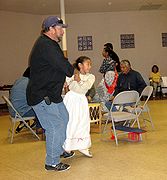Post-contact history[edit]
The Caddo first encountered Europeans in 1541 when the Hernando de Soto Expedition came through their lands.[15] De Soto's force had a violent clash with one band of Caddo Indians, the Tula, near Caddo Gap, Arkansas. This event is marked by a monument that stands in the small town today.
The Caddo tribes were divided into three confederacies when first encountered by the Europeans, the Hasinai, Kadohadacho, and Natchitoches, and loosely affiliated with other tribes. The Haisinai lived in East Texas, the Kadohadacho lived near the border of Texas, Oklahoma, and Arkansas, and the Natchitoches lived in now northern Louisiana.[16]
With the arrival of missionaries from Spain and France, a smallpox epidemic broke out that decimated the population. Measles, influenza, and malaria also devastated the Caddo, as these were Eurasian diseases to which they had no immunity.[13]
Before extensive European contact, some of the Caddo territory was invaded by migrating Osage, Ponca, Omaha and Kaw, who had moved west beginning about 1200 CE due of years of warfare with the Iroquois in the Ohio River area of present-day Kentucky. The Osage particularly dominated the Caddo and pushed them out of some former territory, becoming dominant in the region of Missouri, Arkansas, Kansas and Oklahoma. The new tribes had become well settled in their new traditional grounds west of the Mississippi by mid-18th century European contact.[13]
Having given way over years before the power of the former Ohio Valley tribes, Caddos later negotiated for place with Spanish, French, and finally Anglo-American settlers. After the 1803 Louisiana Purchase, the United States government sought to ally with the Caddos. After the War of 1812, American Generals like William Henry Harrison, William Clark, and Andrew Jackson had crushed pro-British Indian uprisings. Due to their neutrality and their importance as a source of information for the Louisiana government, the Caddo were left alone until the 1830s.[17] In 1835 the Kadohadacho, the northernmost Caddo confederacy, signed a treaty with the US to relocate to then Mexico. This area had been rapidly transformed by greatly increased immigration of European Americans, who in 1836 declared independence from Mexico with the Republic of Texas.[13] "Texas" comes from the Hasinaiword táysha?, meaning "friend."[18]
In 1845 when Texas was admitted to the US as a state, the government forced the relocation of both the Hasinai and the Kadohadacho onto the Brazos Reservation. In 1859 many of the Caddo were relocated to Indian Territory west of the Mississippi River. After the Civil War, the Caddo were concentrated on a reservation located between the Washita and Canadian rivers.[13]
In the late 19th century, the Caddo took up the Ghost Dance religion, which was widespread among American Indian nations in the West. John Wilson, a Caddo-Delaware medicine man who spoke only Caddo, was an influential leader in the Ghost Dance. In 1880, Wilson became a peyote roadman. The tribe had known the Half Moon peyote ceremony, but Wilson introduced the Big Moon ceremony to them.[19] The Caddo tribe remains very active in the Native American Church today.
After the turn of the century, the Curtis Act dismantled tribal institutions. The Dawes Act was directed at assimilation by breaking up tribal common landholdings into allotments for individual members. The Caddo vigorously opposed allotment. Whitebread, a Caddo leader, said, that "because of their peaceful lives and friendship to the white man, and through their ignorance were not consulted, and have been ignored and stuck away in a corner and allowed to exist by sufferance."[13]
The Oklahoma Indian Welfare Act of 1936 provided the opportunity for the Caddo to reform their tribal government. They organized in 1938 as the Caddo Indian Tribe of Oklahoma. They ratified their constitution on 17 January 1938.[2] In 1976, they drafted a new constitution. During the 20th century, Caddo leaders such as Melford Williams, Harry Guy, Hubert Halfmoon, and Vernon Hunter have shaped the tribe.[13]
In a special election on 29 June 2002, six amendments were made to the constitution. Tribal enrollment is open to individuals with a documented minimum of 1/16 degree Caddo blood quantum.[20]
In August 2013, a group led by Philip Smith attempted to recall Brenda Shemayme Edwards, the Chairman of the Tribal Council. After that attempt failed, in October 2013, Philip Smith and his supporters broke into the Caddo Nation headquarters. They chained the front doors from the inside and blocked off the entrance to the administration building. The Bureau of Indian Affairs Police were called.[21]
Notable Caddo[edit]
- T. C. Cannon, Kiowa-Caddo artist
- LaRue Parker, former tribal chairperson
- Jeri Redcorn, Caddo-Potawatomi potter
- John Wilson, peyote roadman
See also[edit]
- Caddoan village bundle
- Caddo Lake
- Dush-toh, traditional Caddo women's hair ornament
- List of sites and peoples visited by the Hernando de Soto Expedition
- Spiro Mounds





No comments:
Post a Comment